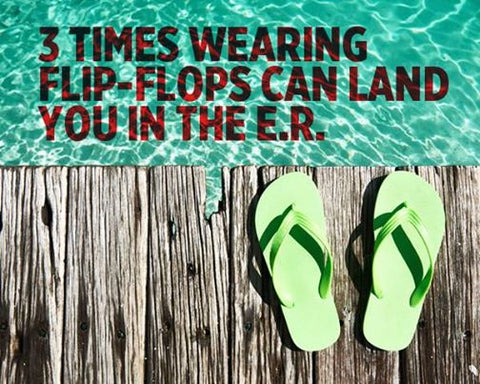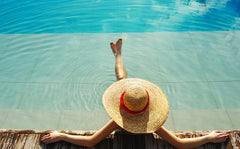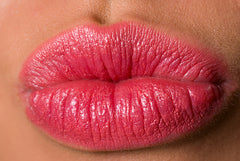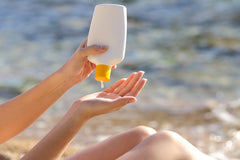Get Sporty

Getting a leg-up on some of your favorite outdoor activities often means finding the right shoes for the task-at-hand (err foot!). Check out these features to keep in mind when spotting the right shoes to get sporty!
Walking:
Whether you’re an avid walker or just in-need of a solid athletic shoe, this style is for you! You want a walking shoe that is lightweight allowing easy, comfortable mobility. Cushioning and shock absorption should be sufficient, but not be overly rigid. Instead, the sole should have flexibility and a rounded bottom, enabling a fluid motion for heel striking and toeing off, when walking.
Running:
Running can expose your feet to forces up to 3 times your body weight. Look for a running shoe that has ample shock absorption. This protects your feet from taking a beating when pounding the pavement over time. Running is a higher impact activity than walking, so it is a good idea for your running shoe to have a rigid sole (NOT flexible). The rigid sole should ONLY bend at the ball of the foot.
Hard Surface Activities:
Hard surface activities can mean murderous wear-n-tear not only to your feet BUT to your shoes, as well! That’s because these activities- such as basketball and tennis-involve lateral movements, abrupt stopping, and running. A quality basketball shoe should have thick shock absorption and a rigid sole to offload impact from running and jumping. It is recommended that basketball shoes are high-tops to provide added stability with lateral movement. High-tops are also believed to aid in ankle stability, but do not completely eliminate the risk of ankle sprains/injuries. Tennis shoes should have a thicker sole that is rigid and is only flexible at the ball of the foot for stability and repetitive movements. A sole with more tread is also good to keep in mind for added traction with abrupt stops.
Cross-Trainer:
Like to indulge in a variety of outdoor activities? Then a cross-training shoe might be the way to go. Viewed as a hybrid athletic shoe, this style combines features form various specialty shoes to accommodate the jack (or jill)-of-all-trades.
Want more information on finding the right “kicks” for the right activity? Check out our series Soul Searching: 8 Tips to Finding Your Perfect of Athletic Shoes!
Putting your best FEET forward,
SH
Safety's Only Skin Deep

Looks like beauty isn’t the only thing that is skin deep. Check out these 3 common types of skin cancer that can turn YOUR summer into an absolute bummer.
Basal Cell Carcinoma
What is it: The most common form of skin cancer that spreads slowly. Appears as a smooth shiny nodule on the skin.
Who is most likely affected: Individuals with a fair skin complexion are most at risk.
Where does it strike: The face is most common, but can be found on any area of the body subject to long term sun damage
When does it occur: Adults over 40 are most commonly diagnosed.
Squamous Cell Carcinoma
What is it: Aggressive form of skin cancer that begins as a scaly red inflamed nodule that develops into an ulcer. Early diagnosis is key because it spreads very quickly.
Who is most likely affected: Fair skinned individuals beware! But anyone who has been subject to prolonged sun exposure should listen up. Smoking can also be a cause.
Where does it strike: The face and back of the hands are the problem areas for men, while the legs and feet are most common for women.
When does it occur: Adults 55 years or older.
Melanoma
What is it: The most deadly- but least common- form of skin cancer. Usually forms from a pre-existing mole or pigmented lesion that is asymmetrical and deformed. Spreads rapidly.
Who is most likely affected: People with light skin complexions are most at risk, especially those with freckles, red hair, or those who burn easily. However as much as 10% of those affected are of dark complexion.
Where does it strike: Areas most exposed to the sun (noticing a theme here?). The face is a common area for men and the legs for women. The soles of the hands and feet and the nails are most often affected by those with darker skin.
When does it occur: Usually found in those that are 50+, but can occur as early as 30 years of age.
As always, monitor the amount of time that you spend in the sun. If you are going to be exposed to the sun for extended periods of time always apply (and RE-apply) your sunscreen when needed. Inspect your skin regularly, and if you note any changes or formations of skin lesions report to your physician immediately. Early diagnosis is key!
Putting your best FEET forward,
SH
Flip Flopped

See why all sandals are NOT created equal, courtesy of Women's Health Magazine.
http://www.womenshealthmag.com/style/wearing-flip-flops?cid=socST_20140716_27948266
Wanna know what to look for when finding the right sandals? Check out these tips!
Putting your best FEET forward,
SH
5 Areas You Don’t Want to Forget to Apply Sunscreen

So you think you’ve slathered on your sunscreen and are ready for a day of fun in the sun…but have you considered these areas? You better!
From HEAD…
Scalp: 
Whether you’re bald or have long luscious locks, an exposed scalp should not be taken lightly for sun protection. Even the smallest part in your (hair)do can reveal enough skin for the sun to do damage. Studies show that melanoma on the scalp can result in a faster rate of death than any other part of the body.
Ears: 
Arms, legs, and face…CHECK! But did you get your ears? They are the 3rd most common site for skin cancer from the sun and should NEVER go untouched. If sunscreen for your ears doesn’t tickle your fancy, try a nice hat with a wide brim to shield you from the sun.
Lips: 
Did you miss a spot with your sunscreen, but can’t figure out where? It could be right under your nose- literally! That’s right the thinner skin and lack of melanin in your lips make them especially vulnerable to the damage from harmful sun rays. It’s best to use lip balm with SPF to keep your kisser in good condition!
Hands: 
They assist you in applying sunscreen to every other part of your body but it’s easy to forget they need a little help being protected from the sun. The palms may be slathered with sunscreen, but don’t forget the back of your hands.
To TOE…
Feet: 
Going barefoot or wearing sandals means your feet are largely uncovered. That makes your feet very susceptible to sun’s harmful rays. Take care to apply sunscreen to the tops & soles of the feet. Don’t forget between the toes! It is a common hideout spot for melanoma of the feet that should NEVER go unnoticed! Don’t forget the nails!
Putting your best FEET forward,
SH
Sandal Season Survival Series TIP #3: What Lies Beneath

No sandal season is officially underway without finding and sporting the perfect shade of nail polish. But as you polish those lil’ piggies, you may be surprised to know that it's highly recommended that you routinely inspect your nails WITHOUT polish for any lurking signs of skin cancer. We know this may sound like awful news for your summer-ready-pedi but skin cancer can rear its ugly head right under your pretty polished nails. What should you look for? The most notable change can be indicative of malignant melanoma, where a linear mark of increased pigmentation- Hutchinson’s sign- forms on the nail bed (skin underneath the nail). It is also a good idea to examine your cuticles for warts or lesions and the nail itself for any deformities. Every 1-3 months is a suggested time to give your nails a look-see (or sooner depending on your level of sun exposure or prior history of skin cancer). There are brands of nail polish that make the claim of providing UV protection against skin cancer, but it is still recommended that you remove your nail polish periodically to inspect your nails for any possible changes. You cannot check your nails enough and always remember: EARLY DETECTION IS KEY!!
Putting your best FEET forward,
SH
Sandal Season Survival Series TIP #2: Pssst! Your Epidermis Is Showing

Wanna REALLY get sandal season into full swing?...Then sunscreen is an absolute must-have to keep in your arsenal to survive the summer safely. The face, back, arms and legs are all the craze when it comes to applying sunscreen, but it’s also a very good idea to slather the tootsies to protect them from the harmful sun rays. To protect your feet from the sun:
• Apply sunscreen with a minimum Sun Protection Factor (SPF) of 30. You want to lookout for sunscreens that are labeled “water-resistant” and “broad spectrum” that hold up against water exposure and protect you from both UVB (contributes to melanoma) and UVA (causes skin damage) rays.
• Sunscreen should be applied at least 30 minutes prior to going outdoors. It takes approximately 15 minutes for your skin to fully absorb the sunscreen you apply. If you wait until you are outside to apply, you run the harmful risk of your skin becoming scorched by the sun.
• Make sure ALL exposed skin is protected. Wearing sandals means your feet are largely uncovered. That makes your feet very susceptible to sun’s harmful rays. Take care to apply sunscreen to the tops & soles of the feet. Don’t forget between the toes! It is a common hideout spot for melanoma of the feet that should NEVER go unnoticed! With creams you always want to be careful when applying between the toes however. Do not place too much cream in between the toes to prevent any macerations (breakdown) of the skin.
• Reapply! Just because you applied sunscreen before going outdoors does not mean you’re fully protected. You should always reapply sunscreen every 1-2 hours while frolicking in the sun. Certain factors such as water exposure, excessive sweating, and individuals with reduced skin pigmentation may require more frequent reapplications.
No matter if it’s the summertime or any other time of the year, ALWAYS inspect your skin for any potential changes, paying very close attention to any moles or lesions that may be present. If you suspect any changes in your skin, report to your physician immediately!
Tip #3 on the way…
Putting your best FEET forward,
SH
Sandal Season Survival Series TIP #1: You Gotta Have Sole

When getting to the bottom of finding the right sandals for summer, you always want to pay very close attention to the soles. A sole-ful sandal is a safer sandal that provides you with the proper cushioning, comfort, and support. Sandals that have a thicker sole (atleast ½ inch thick) are ideal. That means: Flip Flops BEWARE. Sure, they may be oh-so-convenient to slide on your feet and go on with your day, but no arch support and a flimsy sole can often make them a not-so-wise option. If you are ever unsure if you sandals are suitable for wearing, you should perform a flexion test and torsion test. Ladies, if height is what you crave, wedged sandals are best rather than heels. A wider base gives you greater support, balance, and comfort. Rubber or even cork are suitable sole materials that provide support. Cork is highly recommended as it can conform to the shape of your feet. So here's to fun- AND comfort- in the sun this summer!
Stay tuned for TIP #2!
Putting your best FEET forward,
SH
Pamper Scamper

Looking for the right salon to get those tootsies touched up for sandal season? Here are 9 rules we found that we think you should know....courtesy of elle.com!
Putting your best FEET forward,
SH
Not So Fun In The Sun

According to the American Cancer Society, skin cancer is the most common cancer found in the United States, with melanoma being the most dangerous form. But in your pursuit of having fun in the sun this summer, do you know what changes to spot to make sure your skin remains safe from head to toe? Check out these common signs of melanoma from A to Z....err E!
Asymmetry: Moles that are uniform in shape should give little cause for concern. However, a mole where one half is different from the other half could indicate melanoma.
Borders: Moles should have borders that are smooth and consistent. A lesion may be cancerous if you notice its borders being jagged and irregular.
Color: Always look for moles to be one solid color (typically brown or tan). Moles that are multi-colored or speckled are likely melanoma.
Diameter: Moles that are less than 6mm (1/4in)- the width of a pencil eraser- are usually harmless. However if they exceed 6mm, then you should suspect melanoma.
Elevation: Inspect if a lesion is flat or elevated. Lesions that are raised above the surface of the skin often appear in the occurrence of melanoma.
What the FOOT!?!: Have you heard of Hutchinson’s Sign? It is a linear mark of increased pigmentation indicating melanoma under the nail. It begins at the base of the nail and extends towards the tip of the nail. It is always a good to remove nail polish and examine nails to note any potential changes under your nails.

Other places to note melanoma of the foot: top of the foot, sole, and in between the toes.
If you suspect any changes in moles or lesions to your skin, report to your physician immediately! And remember, early detection is ALWAYS key, with any form of cancer. The sooner it can be diagnosed, the far better chance you have of recovery.
Putting your best FEET forward,
SH
THE MOTHERLOAD (Part 2): Preggers CAN Be Choosers

Just because a baby’s on board doesn’t mean your daily activities have to take a back seat. Whether you’re breakin’ a sweat, layin’ low, or steppin’ out for the evening, here are some tips on what to lookout for in the right shoes you can use for any mama-in-the-making!
SPORTY PREGGERS
A proper athletic shoe always does a (pregnant) body good for any type of workout. When on the quest for the proper shoe, you want to check for 3 things: 1) a rigid sole with shock absorption, 2) a wide toe box, and 3) arch support. A rigid sole with shock absorption protects your feet from forces caused from the added weight they have to support along with the forces and impact from the ground from walking and excessive activity. A wider toe box is essential to accommodate for the increased width and frequent swelling of the feet that may occur. Lax ligaments and reduced arches can also contribute to wider feet. Therefore, having ample arch support maintains the pregnant foot in a more ideal position for a successful workout. Remember, if your feet are in a their proper position, that means less stress for your ankles, knees, hips, and lower back!
CASUAL PREGGERS
As tempting as it may be, going barefoot is a no-go for any future mama. Sure, going shoeless may be comfortable when at home, but it makes your feet a target for debris that you may have the displeasure of stepping on. Anything that can pierce your feet can lead to injury or even infection, which during pregnancy is added (unnecessary) worry. Also, going barefoot provides no arch support, which for flatfeet puts added stress on the ankles, knees, hips, and lower back. Instead, always wear some type of house shoe- the thicker the sole the better. Remember, coverage is the key-that also means NO flip-flops/thongs…sorry! If you’re out-n-about, a great athletic shoe is always an option. However if you’re in the mood for something more laid back, clogs are nice options. They are backless (giving your feet the feeling of being free), but still provides coverage and support.
CLASSY PREGGERS
You’ve found the perfect outfit for that very special occasion and you’re thinking to yourself that nothing would set-off this outfit more than a swanky pair of heels, right!...Oh HEEL no! In terms of high heels, height is not your friend. Increased weight in the belly region makes for a change in gait and altered balance. Falling can hurt you and the child. However if you just have to have some elevation, shoes with a short wedged heel (~2in high) are a reasonable alternative. The wider sturdier heel provides better rearfoot and ankle support for better balance and walking.
Putting your best FEET forward,
SH




